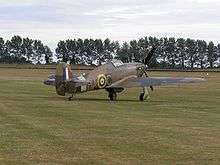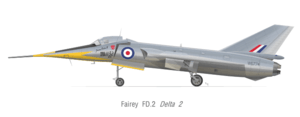Robert Lickley
Sir Robert Lang Lickley CBE FRSE FREng FRAeS FIEE (19 January 1912 – 7 July 1998) was a Scottish aeronautical engineer, and the designer of the Fairey Delta 2, the first aircraft to exceed 1,000 mph on 10 March 1956 off the Sussex coast by Peter Twiss.[1]
Sir Robert Lickley | |
|---|---|
Bob Lickley | |
| Born | 19 January 1912 Dundee, Scotland |
| Died | 7 July 1998 (aged 86) Surrey |
| Nationality | Scottish |
| Citizenship | British |
| Education | University of Edinburgh, Imperial College London |
| Occupation | Engineer |
| Spouse(s) | Doris May |
| Children | 1 son, 1 daughter |
| Engineering career | |
| Discipline | Aeronautics |
| Institutions | Institution of Engineering Designers, Royal Aeronautical Society, Institution of Mechanical Engineers |
| Employer(s) | Hawker, Fairey |
| Significant design | Hawker Hurricane |
| Significant advance | Fairey Delta 2 |
| Awards | Gold Medal, RAeS (1957), Taylor Gold Medal, RAeS (1958) |
Early life
Lickley was born in Dundee in Scotland and was educated the High School of Dundee. He studied Civil Engineering at the University of Edinburgh where he graduated BSc, and then went on to Imperial College London as a postgraduate, where he studied Aeronautics on a Caird Scholarship.[2]
Career
Hawker

Lickley joined the stress office of Hawker at Kingston upon Thames in 1933. He worked on a new single-seat eight-gun monoplane for specification F5/34. This became the Hawker Hurricane, which first flew in 1935.
As a Chief Project Engineer he worked on the Typhoon, Tempest, and Sea Fury. He worked on Hawker's entry into jet flight, the P.1040, which became the Sea Hawk.
Cranfield
He became Professor of Aircraft Design in 1946 at the new College of Aeronautics at Cranfield, which became Cranfield University.
Fairey

In November 1951 Lickley became Technical Director and Chief Engineer of Fairey Aviation, initially working on the Fairey Gannet, including the AEW version. He developed a team of aerodynamicists and mathematicians at their headquarters at Hayes in Middlesex. Fairey was also based in northern Cheshire.
In 1956 his team produced the Fairey Delta 2, and kept its existence top secret. When it broke the world speed record by more than 300 mph, the Americans knew nothing of the aircraft beforehand, using a practice known as Chinese walls.
At the same time the Fairey Rotodyne compound gyroplane was being developed, a successful aircraft that was cancelled in 1962 for financial reasons and noise. The 48-seat aircraft had been planned for the London-Paris route. It also developed the Fairey Ultra-light Helicopter for the Royal Navy, but was not adopted. The company developed the Fireflash, the UK's first air-to-air missile, from its site at Heston. The total engineering team and staff at Hayes was around 1,000. He became Managing Director. Part of the company also helped to build the Trawsfynydd nuclear power station.
The British Conservative government cancelled Fairey's new fighter, based on the FD2. A Fairey Delta 3 had also been planned. The French government however were less unsympathetic, and their main (and highly successful) Mirage fighter aircraft was based on the Fairey Delta 2. The FD2 had a drooped nose (10 degrees) which was later developed for Concorde.
Institutions
In the 1950s Lickley was a member of the Aeronautical Research Council and Society of British Aerospace Companies. He received an Honorary Doctorate of Science from the University of Edinburgh in 1973 and from the University of Strathclyde in January 1987. He worked with the Science and Engineering Research Council (SERC).
In 1977 he was elected a Fellow of the Royal Society of Edinburgh. His proposers were Donald McCallum, Sir John Atwell, Francis Penny and Thomas Diery Patten.[3]
On 25 November 1981, speaking as President of the Institution of Production Engineers, he said the Government appears to have developed a smooth transfer line which moves the oil revenues to the unemployed without any intervening checks or delays. Instead the checks and delays exist, it would seem, to restrain industry from becoming more efficient and to reduce the likelihood of more young people moving into engineering. At the time his words were echoed by Robert Inskip, 2nd Viscount Caldecote.
Personal life
Lickley married Doris May (d.1997) and they had a son and a daughter. They lived in Walton-on-Thames. He was created a Commander of the Order of the British Empire (CBE) in 1973 and knighted in the 1984 Queen's birthday honours.
References
- Peter Twiss obituary
- Biographical Index of Former Fellows of the Royal Society of Edinburgh 1783–2002 (PDF). The Royal Society of Edinburgh. July 2006. ISBN 0 902 198 84 X.
- Biographical Index of Former Fellows of the Royal Society of Edinburgh 1783–2002 (PDF). The Royal Society of Edinburgh. July 2006. ISBN 0 902 198 84 X.
External links
Video clips
| Preceded by |
President of the Institution of Mechanical Engineers 1971–72 |
Succeeded by |
| Preceded by |
President of the Institution of Production Engineers 1981–82 |
Succeeded by |